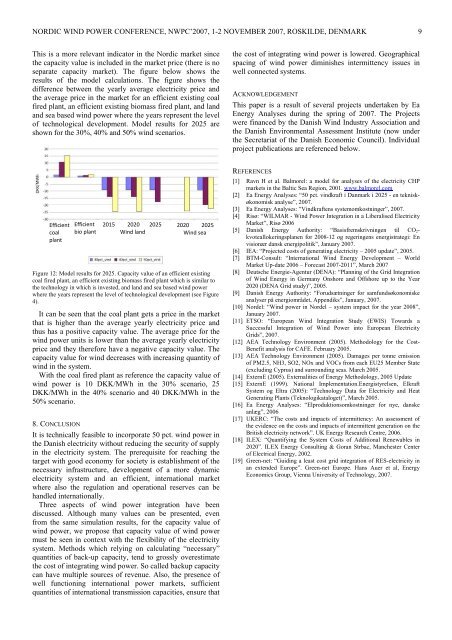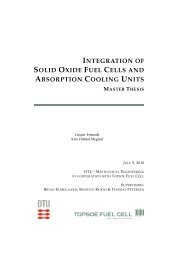NORDIC WIND POWER CONFERENCE, NWPC’2007, 1-2 NOVEMBER 2007, ROSKILDE, DENMARK 8Currently <strong>in</strong> the Danish system, there are two options toensure balanc<strong>in</strong>g with respect to this uncerta<strong>in</strong>ty. Thebalanc<strong>in</strong>g task can be left to the system operator,Energ<strong>in</strong>et.dk, or it can be h<strong>and</strong>led privately. Energ<strong>in</strong>et.dkcharge a balanc<strong>in</strong>g tariff, currently 23 DKK/MWh fed <strong>in</strong>tothe system. This is used to f<strong>in</strong>ance the purchase of balanc<strong>in</strong>gpower from other generators <strong>in</strong> the system. This price isdriven by the average price on balanc<strong>in</strong>g power <strong>and</strong> theaverage prediction error of w<strong>in</strong>d power between submitt<strong>in</strong>gbids to the spot market <strong>and</strong> the hour of operation. The levelof the balanc<strong>in</strong>g costs <strong>in</strong> 2005-2006 was 30 DKK/MWh for<strong>Ea</strong>stern <strong>Denmark</strong> [2] <strong>and</strong> the average prediction error hasbeen estimated to be 35% when the bid is given 13-36 hoursbefore the hour of operation as it is today <strong>in</strong> the Nordpoolmarket [2].S<strong>in</strong>ce w<strong>in</strong>d power is <strong>in</strong>creased from now until 2025 <strong>in</strong> thesimulation it has been chosen to use an <strong>in</strong>creas<strong>in</strong>g cost ofbalanc<strong>in</strong>g from 20 DKK/MWh to 40 DKK/MWh <strong>in</strong> 2025.This is founded on a number of assumptions.- Market development, especially the active use of theNordic <strong>in</strong>traday market Elbas, will <strong>in</strong>crease until2025, hence put pressure on the price of regulat<strong>in</strong>gpower.- Balanc<strong>in</strong>g power trade will exp<strong>and</strong> <strong>in</strong>ternationally.Balanc<strong>in</strong>g Danish w<strong>in</strong>d power with Nordic hydropower for <strong>in</strong>stance.- Improvements <strong>in</strong> w<strong>in</strong>d power forecast<strong>in</strong>g methods<strong>and</strong> or changes <strong>in</strong> market design to betteraccommodate w<strong>in</strong>d power (i.e. by mov<strong>in</strong>g spot bidscloser to the hour of operation). It is assumed thatthe average error <strong>in</strong> prediction will decrease to 25%.(This assumption means that the cost of balanc<strong>in</strong>g <strong>in</strong>general is assumed to <strong>in</strong>crease to 160 DKK/MWh <strong>in</strong>2025, thus giv<strong>in</strong>g a cost for balanc<strong>in</strong>g w<strong>in</strong>d powerof 40 DKK/MWh).With respect to w<strong>in</strong>d power generation forecasts it is alsoimportant to note that with <strong>in</strong>creased w<strong>in</strong>d powercompetition between forecast<strong>in</strong>g methods is <strong>in</strong>tensified. Thisadds robustness to the forecasts as different w<strong>in</strong>d powergenerators will use different forecast<strong>in</strong>g methods, thusdiversify<strong>in</strong>g the effects of unavoidable systemic errors <strong>in</strong>forecast methods.7.1. Evaluat<strong>in</strong>g the capacity value of w<strong>in</strong>d powerAs mentioned above the <strong>in</strong>termittent nature of w<strong>in</strong>d poweris implicitly <strong>in</strong>cluded <strong>in</strong> the model calculations. The capacityvalue of w<strong>in</strong>d power can be evaluated from the modelresults.The term capacity value is used to express the value ofgeneration to the electricity system. Basically this is aquestion of tim<strong>in</strong>g: plants which are able to adjust theirproduction accord<strong>in</strong>g to the system dem<strong>and</strong> have a highvalue whereas <strong>in</strong>termittent technologies such as w<strong>in</strong>d powerwould usually have a lower value.There are several ways to assess the capacity value of anelectricity production technology. In a well developedelectricity market, the value of the electricity production canbe assessed as the price a technology may obta<strong>in</strong> <strong>in</strong> theelectricity market. In the Nordic market there is no separatecapacity value payment <strong>and</strong> it can thus be assumed that thespot price <strong>in</strong> the mature electricity market reflects the realvalue of electricity production (energy <strong>and</strong> capacity value)hour by hour. In other studies, the capacity value has beenassessed <strong>in</strong> different ways – for <strong>in</strong>stance for w<strong>in</strong>d power, ithas been estimated what the extra <strong>in</strong>vestment will be forsufficient backup capacity for periods without w<strong>in</strong>d.Based on an evaluation of the value of w<strong>in</strong>d powerelectricity <strong>in</strong> the market <strong>Ea</strong> Energy Analyses have previouslyestimated the capacity value of w<strong>in</strong>d power to be 20DKK/MWh [16].A UKERC [17] report estimates the costs to ma<strong>in</strong>ta<strong>in</strong>system reliability to be 37 – 60 DKK/MWh under Britishconditions. IEA [6] refers to the ILEX [18] study <strong>and</strong> theGreen-net study [19] <strong>and</strong> estimates the capacity costs of w<strong>in</strong>dpower to be between 22 <strong>and</strong> <strong>50</strong> DKK/MWh.The capacity value is not a constant technology parameter.The value of w<strong>in</strong>d power for the system is very dependent onthe <strong>in</strong>cumbent capacity of the system. In a system with highpenetration of hydropower with reservoirs or with many fastregulat<strong>in</strong>g gas turb<strong>in</strong>es, the capacity value for w<strong>in</strong>d powerwill be high, compared to a system with an abundance ofslowly regulat<strong>in</strong>g nuclear or coal power.As expla<strong>in</strong>ed earlier the Balmorel model was used tocalculate a reference scenario based on market driven<strong>in</strong>vestments <strong>and</strong> a scenario where a target of <strong>50</strong> <strong>pct</strong>. w<strong>in</strong>dpower was implemented. Furthermore, two scenarios with atarget of 30 <strong>pct</strong>. <strong>and</strong> 40 <strong>pct</strong>. w<strong>in</strong>d power have beencalculated. In order to analyze the capacity value of w<strong>in</strong>dpower the table below shows the <strong>in</strong>stalled new w<strong>in</strong>d powercapacity <strong>in</strong> the 3 scenarios as well as the quantity of thermalcapacity replaced by the new w<strong>in</strong>d power capacity.Table 7: Investments <strong>in</strong> thermal <strong>and</strong> w<strong>in</strong>d power capacity <strong>in</strong> the 30 <strong>pct</strong>., 40<strong>pct</strong>. <strong>and</strong> <strong>50</strong> <strong>pct</strong> w<strong>in</strong>d power scenarios compared to the reference scenario.New <strong>in</strong>vestments <strong>in</strong> w<strong>in</strong>dpower capacity (MW)Reduced <strong>in</strong>vestment <strong>in</strong>thermal capacity comparedto the reference scenario(MW)Replaced thermal capacity /new w<strong>in</strong>d power30 <strong>pct</strong>.w<strong>in</strong>d40 <strong>pct</strong>.w<strong>in</strong>d<strong>50</strong> <strong>pct</strong>.w<strong>in</strong>d3,589 4,539 5,670943 1,132 1,4590.263 0.249 0.257The model results show that for each MW of w<strong>in</strong>d powerthe <strong>in</strong>vestments <strong>in</strong> thermal plants are reduced by 0.25-0.26MW. In other terms for each MW of w<strong>in</strong>d power 0.75 MWof thermal capacity is required accord<strong>in</strong>g to the model. In thecase that all this extra capacity is built only to h<strong>and</strong>le the<strong>in</strong>termittent nature of w<strong>in</strong>d power <strong>and</strong> ensure that power canbe supplied <strong>in</strong> every hour also when the w<strong>in</strong>d does notproduce the extra costs can be calculated by calculat<strong>in</strong>g theextra capacity costs of the needed thermal capacity.Assum<strong>in</strong>g that the 0.75 MW pr. MW w<strong>in</strong>d is established ass<strong>in</strong>gle cycle gas turb<strong>in</strong>es at 3.5 million DKK/MW the yearlycapacity cost of 1 MW off shore w<strong>in</strong>d power will be 73DKK/MWh. However, this will be an upper limit of thecapacity cost related to the w<strong>in</strong>d power s<strong>in</strong>ce the extra gasturb<strong>in</strong>e capacity can also be used for other purposes <strong>in</strong> theelectricity market.Another <strong>in</strong>dicator of capacity value is the average MWhpriceawarded to w<strong>in</strong>d power <strong>in</strong> the market, <strong>in</strong> comparisonwith the average electricity price <strong>and</strong> other technologies.
NORDIC WIND POWER CONFERENCE, NWPC’2007, 1-2 NOVEMBER 2007, ROSKILDE, DENMARK 9This is a more relevant <strong>in</strong>dicator <strong>in</strong> the Nordic market s<strong>in</strong>cethe capacity value is <strong>in</strong>cluded <strong>in</strong> the market price (there is noseparate capacity market). The figure below shows theresults of the model calculations. The figure shows thedifference between the yearly average electricity price <strong>and</strong>the average price <strong>in</strong> the market for an efficient exist<strong>in</strong>g coalfired plant, an efficient exist<strong>in</strong>g biomass fired plant, <strong>and</strong> l<strong>and</strong><strong>and</strong> sea based w<strong>in</strong>d power where the years represent the levelof technological development. Model results for 2025 areshown for the 30%, 40% <strong>and</strong> <strong>50</strong>% w<strong>in</strong>d scenarios.the cost of <strong>in</strong>tegrat<strong>in</strong>g w<strong>in</strong>d power is lowered. Geographicalspac<strong>in</strong>g of w<strong>in</strong>d power dim<strong>in</strong>ishes <strong>in</strong>termittency issues <strong>in</strong>well connected systems.ACKNOWLEDGEMENTThis paper is a result of several projects undertaken by <strong>Ea</strong>Energy Analyses dur<strong>in</strong>g the spr<strong>in</strong>g of 2007. The Projectswere f<strong>in</strong>anced by the Danish <strong>W<strong>in</strong>d</strong> Industry Association <strong>and</strong>the Danish Environmental Assessment Institute (now underthe Secretariat of the Danish Economic Council). Individualproject publications are referenced below.EfficientcoalplantEfficientbio plant2015 2020 2025<strong>W<strong>in</strong>d</strong> l<strong>and</strong>2020 2025<strong>W<strong>in</strong>d</strong> seaFigure 12: Model results for 2025. Capacity value of an efficient exist<strong>in</strong>gcoal fired plant, an efficient exist<strong>in</strong>g biomass fired plant which is similar tothe technology <strong>in</strong> which is <strong>in</strong>vested, <strong>and</strong> l<strong>and</strong> <strong>and</strong> sea based w<strong>in</strong>d powerwhere the years represent the level of technological development (see Figure4).It can be seen that the coal plant gets a price <strong>in</strong> the marketthat is higher than the average yearly electricity price <strong>and</strong>thus has a positive capacity value. The average price for thew<strong>in</strong>d power units is lower than the average yearly electricityprice <strong>and</strong> they therefore have a negative capacity value. Thecapacity value for w<strong>in</strong>d decreases with <strong>in</strong>creas<strong>in</strong>g quantity ofw<strong>in</strong>d <strong>in</strong> the system.With the coal fired plant as reference the capacity value ofw<strong>in</strong>d power is 10 DKK/MWh <strong>in</strong> the 30% scenario, 25DKK/MWh <strong>in</strong> the 40% scenario <strong>and</strong> 40 DKK/MWh <strong>in</strong> the<strong>50</strong>% scenario.8. CONCLUSIONIt is technically feasible to <strong>in</strong>corporate <strong>50</strong> <strong>pct</strong>. w<strong>in</strong>d power <strong>in</strong>the Danish electricity without reduc<strong>in</strong>g the security of supply<strong>in</strong> the electricity system. The prerequisite for reach<strong>in</strong>g thetarget with good economy for society is establishment of thenecessary <strong>in</strong>frastructure, development of a more dynamicelectricity system <strong>and</strong> an efficient, <strong>in</strong>ternational marketwhere also the regulation <strong>and</strong> operational reserves can beh<strong>and</strong>led <strong>in</strong>ternationally.Three aspects of w<strong>in</strong>d power <strong>in</strong>tegration have beendiscussed. Although many values can be presented, evenfrom the same simulation results, for the capacity value ofw<strong>in</strong>d power, we propose that capacity value of w<strong>in</strong>d powermust be seen <strong>in</strong> context with the flexibility of the electricitysystem. Methods which rely<strong>in</strong>g on calculat<strong>in</strong>g “necessary”quantities of back-up capacity, tend to grossly overestimatethe cost of <strong>in</strong>tegrat<strong>in</strong>g w<strong>in</strong>d power. So called backup capacitycan have multiple sources of revenue. Also, the presence ofwell function<strong>in</strong>g <strong>in</strong>ternational power markets, sufficientquantities of <strong>in</strong>ternational transmission capacities, ensure thatREFERENCES[1] Ravn H et al. Balmorel: a model for analyses of the electricity CHPmarkets <strong>in</strong> the Baltic Sea Region, 2001. www.balmorel.com[2] <strong>Ea</strong> Energy Analyses: “<strong>50</strong> <strong>pct</strong>. v<strong>in</strong>dkraft i Danmark i 2025 - en tekniskøkonomiskanalyse”, 2007.[3] <strong>Ea</strong> Energy Analyses: ”V<strong>in</strong>dkraftens systemomkostn<strong>in</strong>ger”, 2007.[4] Risø: “WILMAR - <strong>W<strong>in</strong>d</strong> <strong>Power</strong> Integration <strong>in</strong> a Liberalised ElectricityMarket”, Risø 2006[5] Danish Energy Authority: “Basisfremskrivn<strong>in</strong>gen til CO 2 -kvotealloker<strong>in</strong>gsplanen for 2008-12 og reger<strong>in</strong>gens energistrategi: Envisionær dansk energipolitik”, January 2007.[6] IEA: “Projected costs of generat<strong>in</strong>g electricity – 2005 update”, 2005.[7] BTM-Consult: “International <strong>W<strong>in</strong>d</strong> Energy Development – WorldMarket Up-date 2006 – Forecast 2007-2011”, March 2007[8] Deutsche Energie-Agentur (DENA): “Plann<strong>in</strong>g of the Grid Integrationof <strong>W<strong>in</strong>d</strong> Energy <strong>in</strong> Germany Onshore <strong>and</strong> Offshore up to the Year2020 (DENA Grid study)”, 2005.[9] Danish Energy Authority: “Forudsætn<strong>in</strong>ger for samfundsøkonomiskeanalyser på energiområdet, Appendiks”, January, 2007.[10] Nordel: “<strong>W<strong>in</strong>d</strong> power <strong>in</strong> Nordel – system impact for the year 2008”,January 2007.[11] ETSO: “European <strong>W<strong>in</strong>d</strong> Integration Study (EWIS) Towards aSuccessful Integration of <strong>W<strong>in</strong>d</strong> <strong>Power</strong> <strong>in</strong>to European ElectricityGrids”, 2007.[12] AEA Technology Environment (2005). Methodology for the Cost-Benefit analysis for CAFE. February 2005.[13] AEA Technology Environment (2005). Damages per tonne emissionof PM2.5, NH3, SO2, NOx <strong>and</strong> VOCs from each EU25 Member State(exclud<strong>in</strong>g Cyprus) <strong>and</strong> surround<strong>in</strong>g seas. March 2005.[14] ExternE (2005). Externalities of Energy Methodology, 2005 Update[15] ExternE (1999). National Implementation.Energistyrelsen, ElkraftSystem og Eltra (2005): “Technology Data for Electricity <strong>and</strong> HeatGenerat<strong>in</strong>g Plants (Teknologikataloget)”, March 2005.[16] <strong>Ea</strong> Energy Analyses: “Elproduktionsomkostn<strong>in</strong>ger for nye, danskeanlæg”, 2006[17] UKERC: “The costs <strong>and</strong> impacts of <strong>in</strong>termittency: An assessment ofthe evidence on the costs <strong>and</strong> impacts of <strong>in</strong>termittent generation on theBritish electricity network”. UK Energy Research Centre, 2006.[18] ILEX: “Quantify<strong>in</strong>g the System Costs of Additional Renewables <strong>in</strong>2020”. ILEX Energy Consult<strong>in</strong>g & Goran Strbac, Manchester Centerof Electrical Energy, 2002.[19] Green-net: “Guid<strong>in</strong>g a least cost grid <strong>in</strong>tegration of RES-electricity <strong>in</strong>an extended Europe”. Green-net Europe. Hans Auer et al, EnergyEconomics Group, Vienna University of Technology, 2007.
















